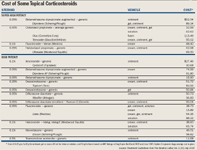Rotational therapies aid in treating psoriasis
Mild to moderate psoriasis is generally treated first with topical corticosteroids and other topical remedies. When the disease is widespread or unresponsive to topical agents, ultraviolet phototherapy may be used at home or in the physician's office.

When these remedies are not sufficient, systemic therapy is indicated. Methotrexate in low doses is highly effective for psoriasis. However, the drug is contraindicated in pregnancy, and patients on methotrexate must be monitored for rare but potentially fatal liver toxicity. Cyclosporine has been as effective as methotrexate in treating moderate to severe psoriasis. However, it interacts with many other drugs, and can lead to renal problems. "Psoriasis can be a serious condition," notes Mark Abramowicz, MD, editor of The Medical Letter on Drugs and Therapeutics, a non-profit newsletter that critically appraises drugs. "If it weren't, no one would be using these high-powered medications."
Nowadays, biologic agents such as T-cell inhibitors and tumor-necrosis-factor (TNF) inhibitors are used to treat psoriasis. They include:
However, biologic agents do offer the possibility of long-lasting remissions. For example, one study of Amevive found that after two 12-week courses of treatment, up to 40% of patients achieved a 75% reduction in disease, and 71% achieved a 50% reduction, with remissions lasting for as long as a year without further treatment.
According to a consensus statement on psoriasis published by the American Academy of Dermatology, rotational therapy may minimize the long-term toxicity associated with any given therapy and decrease resistance to that therapy. With this strategy, one medication is used for a specified period of time, and then the patient switches to an alternative therapy.
"This is a difficult condition to treat," Dr. Abramowicz says. "It's chronic, and the various treatments are all somewhat toxic. This is a situation where a physician must weigh one factor against another."
SEVERITY DIFFICULT TO QUANTIFY
Psoriasis is a persistent disease, with a wide range of individual manifestations. Some people mistakenly think of it as a simple rash, akin to poison ivy or poison oak. "The burden of this disease is not well understood," says Sheila Rittenberg, director of advocacy for the National Psoriasis Foundation. "The rash is painful. It cracks and bleeds. Psoriasis has impact on a person's social life, as well as the ability to work. It can significantly affect someone's quality of life."
One problem for the clinician is how to distinguish mild from moderate psoriasis, or moderate from severe. Just measuring the amount of body surface covered by the rash is not sufficient, says the American Academy of Dermatology. Clinicians should consider the location and effect of the rash as well. "Body surface area should not generally be used to determine which therapies to select," the consensus statement says. "Patients with psoriasis of the palms, soles, head and neck or genitalia or with more than 5% body surface area involvement may be considered to have moderate to severe disease...'Mild' disease, based upon limited body surface area involvement may still warrant phototherapy or systemic therapy, if it does not respond to topicals or if there is disruption of daily activities and/or employment."
David Calabrese of OptumRx Talks New Role, Market Insulin Prices and Other Topics 'On His Mind'
April 13th 2023In this month’s episode of the "What's On Your Mind podcast," Peter Wehrwein, managing editor of MHE connects with the now Chief Clinical Officer of OptumRx Integrated Pharmacies, David Calabrese. In this conversation, David touches on his transition in January as OptumRx’s former chief pharmacy officer and market president of health plans and PBMs to his new role as Chief Clinical Officer where he now focuses more on things such as specialty pharmacy to home delivery — with an overall goal of creating whole-patient care. Throughout the conversation, Calabrese also touched on the market’s hot topic of insulin prices and behavioral health services within the OptumRx community, among other topics.
Listen
Phase 3 Trials of Oral Povorcitinib Show Positive Results in Hidradenitis Suppurativa
March 24th 2025A new drug application for povorcitinib is expected to be filed in late 2025 to early 2026 to treat adult patients with moderate to severe hidradenitis suppurativa, a chronic and painful inflammatory skin condition.
Read More
Briana Contreras, editor of Managed Healthcare Executive, spoke with Nancy Lurker, CEO and president of EyePoint Pharmaceuticals. Nancy shared a bit about EyePoint and how the organization’s innovative therapies are addressing patient needs through eye care, and most importantly, she addressed C-Suite positions like the CEO role. Nancy shared advice for those seeking to reach the CEO level, especially toward women in healthcare and other roles, and what it takes to run a biopharma company.
Listen
Opzelura Topical Cream Drives Incyte's Record Growth in 2024 with 50% Revenue Surge
February 18th 2025Opzelura is a treatment for nonsegmental vitiligo in patients 12 and older, making it the first and only cream in the U.S. that helps restore skin color for this condition. It’s also approved to treat mild to moderate atopic dermatitis in patients 12 and older who are not immunocompromised.
Read More